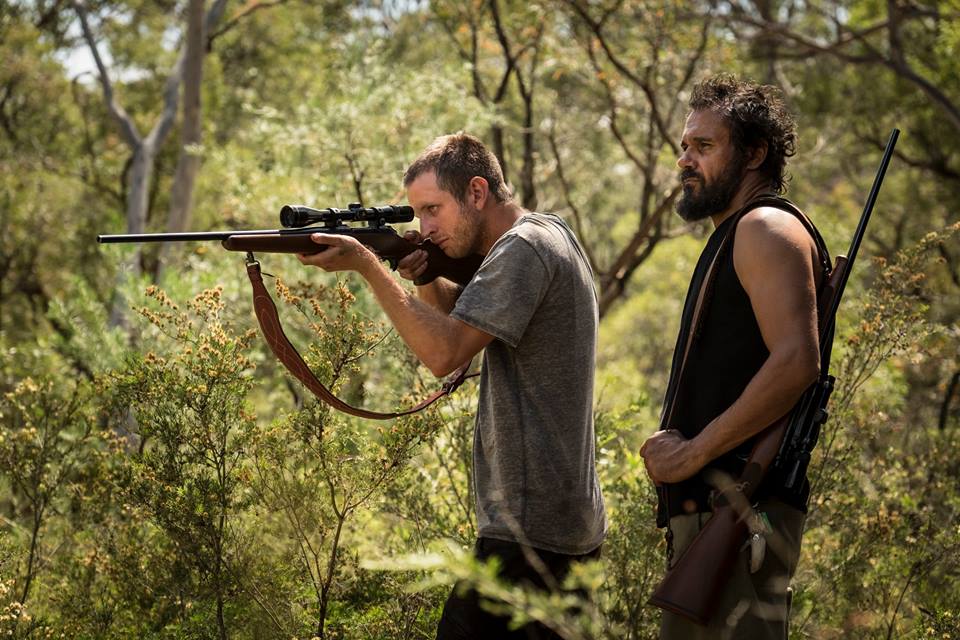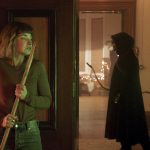If you happen to read various film blogs, you’ll no doubt have heard the term ‘post horror’ being bandied about. It’s a term that is a veritable conundrum – sitting alongside the mid-2000’s created phrases ‘gorno’ or ‘torture porn’. The truth is, ‘post horror’ is a load of bunkum. Just like the ‘torture porn’ tag, it’s intended to try and pigeon hole variations of horror under one banner. By slapping the label ‘post horror’ on films like It Comes At Night or The Witch, it intends to quantify the lack of terror or ‘pure horror’ within those films; in turn, negating what the themes within those films are. Horror does not always need to have you losing sleep and being terrified of what you have witnessed. The old adage of ‘it’s not what you see that frightens you, it’s what you don’t see’ is as apt for The Witch as it is for many other modern horror films – and in this circumstance, Killing Ground.
There is an element of truth within the ‘torture porn’ tagline (ie. the violence on screen is of such a level that both the viewer and the director gets pleasure from it) that has partially driven many of the horror films within the 2000’s and beyond. The Saw and Hostel films are prime examples of this, where closer to home we have had Australian horror films like Wolf Creek and The Loved Ones partially fitting under the manufactured ‘torture porn’ banner. The head on a neck scene in Wolf Creek or the drill sequence within The Loved Ones are intended to make you squirm and cringe, but also to make you eager to see the grotesque outcome from the villains actions.
With Damien Power’s Killing Ground, the term ‘post horror’ and ‘torture porn’ are discarded together in unity into a genre trashcan. Even though this was filmed in 2015, there is an almost prescient nature to Killing Ground with the film recognising the feeble attempt to elevate the horror genre into the realm of ‘esteemed films’ – as if to say that the genre itself has never been worthy of great critical appraisal. (To which I say to those utilising the term ‘post horror’ – do your homework, just like dramas and comedies, horror is a multifaceted genre that isn’t all about a percentage of fear per minute.) What Damien Power has managed to do with Killing Ground is present a common event – camping with your family – in the most terrifying way possible.
To recognise the brilliance of Killing Ground, you need to recognise what it doesn’t do that it easily could have done. Within the horror genre, specifically the ‘slasher’ sub-genre, villains are paramount. Your film lives or dies on the quality of the villain. With Wolf Creek, the human cattle that appear in the wilderness for Mick Taylor to slaughter, are less important than the over the top, exuberant and extremely ocker character that John Jarrat portrays. The same applies to Robin McLeavy’s larger than life Lola in The Loved Ones – a girl who is scorned by the boys at her school, slamming down a challenge to Carrie, demanding a challenge as to who will be the most devilish and bloody prom queen come the gore drenched climax? While both Wolf Creek and The Loved Ones have their benefits, they do tend to follow a familiar trend within horror where the unreal and absurd takes over the real and mundane.
With Killing Ground, Damien Power has opted to create sympathetic, relatable characters (read: victims) over the common route of exaggerated, larger than life villains. Utilising a skewed time motif to help build the growing unease and tension, Killing Ground focuses on the plight of two families – one a young couple heading to the bush to celebrate New Years (Harriet Dyer and Ian Meadows), the other a family headed to a secluded area to celebrate Christmas (Tiarnie Coupland, Maya Stange, Julian Garner, Liam/Riley Parkes). These are families who are doing what is a common occurrence within Australia – heading out to the bush to wind down, relax, and to celebrate life. Damien Power presents this in a simple, matter of fact fashion – these characters feel as real as they can get.
Which in turn makes the appearance of run of the mill blokes Chook (Aaron Glenane) and German (Aaron Pedersen) as the villains of the piece even more terrifying. There appears to be a trend within recent horror to try and distance the horror on screen with real life actions; almost to reassure the viewer that what they are seeing could never happen to them at all. Like a broken record, we swing back to Mick Taylor in Wolf Creek – a villain who was partially inspired by real life serial killer Ivan Milat and the death of Peter Falconio. While he is a terrifying presence within the film, it’s hard not to shake the feeling that outside of being a creation from writer/director Greg McLean’s mind, Mick Taylor would not exist. He has immediately ascended to becoming an otherworldly, omnipresent spectre of the night – appearing with the headlights of his ute lighting up the dark and raring to tear a wayward Norwegian tourist in half. The concept of a murderous Mick Dundee is a frightening one, but instead comes across as a caricature that neither provides laughs or shocks.
Aaron Glenane’s Chook and Aaron Pedersen’s German are simply two guys who live in a rural town and hunt pigs. That’s about it for their back story – and really, it’s all we need. There is a clear recognition that the more mundane and real these blokes are, the easier they will slide under the radar and blend in with society. While Pedersen’s German has a few moments of anger, they are only in the presence of Glenane’s Chook. In lesser hands, the characters of Chook and German could become over the top and schlocky, but the pure commitment to creating believable characters pushes them into a realm that’s far away from Mick Taylor. Audiences have become accustomed to seeing Aaron Pedersen in a position of authority (often playing the role of a police officer), so seeing a usually calm and respectable figure suddenly become a figure of violence and fear is appropriately jarring.
It’s fascinating to see that in 2017 alone there are two horror films that push the genre of Australian horror into interesting, almost untouched areas – Killing Ground and Hounds of Love. Where Hounds of Love draws upon a real world event as its inspiration (and in a way is the cousin of Justin Kurzel’s Snowtown), Killing Ground is one solely conjured from Damien Power’s mind. Where Ben Young’s film made the suburbs of Australia feel dangerous and uninviting, Power’s work will make you question that family trip to the quiet area of the country where the crowds are thinner. Simon Chapman’s cinematography captures a sea of trees that almost consume the viewer, making it easy to lose track of where you are – it’s beautiful, but reminds you that it’s the things you don’t see that are more terrifying than those that you do. Leah Curtis’ score is effective and has impact when it’s needed.
Besides well written characters and a relatable plot, Killing Ground recognises that off screen violence can be more impactful than gore that fills the screen. In one scene, we’re presented with a tableau of corpses, questioning whether we should be thankful that we – unlike the victims – were not privy to what brought about their death, or whether we should be fearful for the impending images that our mind will create in place of not knowing exactly what went on? It’s the hook in the back in The Texas Chainsaw Massacre – we never see the hook enter, but we damn our minds for every image that it creates in response to the absence of gore. Each brutal moment of violence is amplified thanks to the impending doom that is sensed within the quiet, almost serene moments of familial bonding during the opening frames.
Within the terror and doom, we are forced to address a question which most ask after seeing a horror film – how would I act if I were the one in that situation? While we all have elevated notions of how heroic we think we are, it is only when you are in the thick of a moment of terror or catastrophe that you can answer that question. In moments of terror your actions are judged the most. By the third act, Killing Ground moves above being a solid horror film to becoming one which I will remember for a long time. Damien Power has managed to create a truly terrifying Australian horror film that feels all too real.
When I stepped out of Killing Ground, I uncoiled myself from the tight, twisted spool of terror that I’d been wrapped into over the 90 minute run time and immediately said to myself, who is this for? On what grounds can I recommend such a terrifying film in today’s climate? With the real world threat of all-out war looming like a blood soaked guillotine, one has to ask, who is this all too real horror film for? Where Mick Taylor feels over the top and comical, with one liners becoming more memorable than the deaths, in turn making his terrible murders easier to stomach; the calm, almost outwardly average members of society, Chook and German are purely terrifying. They are the guy on the street. They are the every man. They are somebody you may know.
At one point in the film, I found myself recoiling in anger. How can these images be shown on screen? How can these actions be depicted? Why am I not getting up and leaving in disgust? But of course, this is a horror film. This is what horror can be – the depiction of events that bring about fear, trauma and disgust. Horror can make one recoil and cower. Horror can turn a once safe environment in to an unsafe one that breeds fear. Killing Ground, as the title suggests, is the pure embodiment of horror. You shouldn’t feel ease or comfort throughout its run time. You shouldn’t laugh at the villains, you should commit their faces to memory and run if you ever see them again.
There is little joy, there is little relief, and there definitely is no comedy within Killing Ground. This is the outback of fear. If horror is your genre of choice, then you would be doing yourself a huge favour in tracking down Killing Ground – especially given how rare it is for an Australian horror film to get a theatrical release. Damien Power’s film is one that comes from genuine fear for families around Australia enjoying their Christmas break and having that moment of peace destroyed. Even though we may feel like we have conquered the outback, there is a stark reminder that that is never the case. The outback will always fight back in one way or another.
Killing Ground is not post horror. It is not torture porn. It is simply pure fear.
Director: Damien Power
Cast: Harriet Dyer, Aaron Pedersen, Aaron Glenane
Writer: Damien Power



